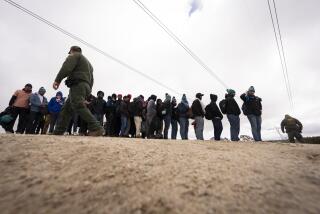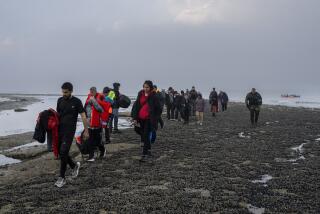Danes Try to Cope With Refugee Influx : Liberalized Law Admits Iranians and Others Seeking Better Life
- Share via
COPENHAGEN — A year after Denmark passed a law offering provisional refuge to almost anyone who declares himself a refugee, this country of 5.1 million is trying to cope with a flood of foreigners seeking a better life in the welfare state.
After handling only 332 asylum-seekers in 1983, police and immigration officials were confronted with more than 4,400 in 1984. The number of new arrivals, mainly Iranians, has risen sharply from month to month.
The tide has overrun facilities, drained refugee funds and apparently has eroded some of the Danes’ self-proclaimed sympathy for the world’s downtrodden.
Some officials insist the law that lets in any asylum-seeker for review of his case is too liberal. They warn against what one termed “the potential for spiraling racism.”
Even Queen Margrethe II departed from her traditionally bland New Year’s Eve speech to give a sharp warning to her subjects about mistreatment of foreigners.
Prompted by Expulsions The reform, which took effect in October 1983, was prompted by a series of heavy-handed expulsions of resident aliens from Denmark, often after brushes with the law.
The new law allows almost anyone who arrives at a Danish entry point seeking asylum to remain, usually at public expense, until his case is reviewed. The process can take months.
Even those refused asylum or expelled from Denmark for other reasons now have the right of appeal before a special immigration review board.
Justice Minister Erik Ninn-Hansen predicted early last month that if the trend continues, Denmark can expect more than 8,000 new arrivals in 1985.
Officials say more than 60% of the refugees have come from Iran, a country whose culture could hardly contrast more with that of progressive, permissive Denmark. The rest are mainly from Iraq, Lebanon, Turkey and Sri Lanka.
The typical Iranian, according to the new Directorate for Aliens, is an educated young man of military conscription age.
In Parliament and around the country, Danes are arguing about whether the great increase is a result of the new law or a worsening of conditions in the refugees’ homelands.
In an interview with the Christian newspaper Kristeligt Dagblad, Mehran Vanhan, an immigrant and chairman for an association of Iranians in Copenhagen, said: “You must understand that people do not flee their own country unless they are forced to.
“It would be a tragedy if Denmark changed its refugee law. . . . I hope it will retain this proof of its democracy.”
Still, Ninn-Hansen has been talking about just that, pointing to what he says he suspects is a great number of “refugees of convenience.”
Asked in Parliament to define the term, he said:
“A number of asylum-seekers cannot substantiate that they, as a result of conditions in their home countries, have good reason to fear repression because of their race, religion, ethnic background, politics or nationality.”
He has proposed a tightening of the law, at least to restore to police the authority to refuse some immigrants at the border if their grounds for seeking asylum obviously are illegitimate.
However, there has not been sufficient parliamentary support for tightening the law.
Politiken, one of the Danish capital’s leading newspapers, said in an editorial: “Although the number of refugees has risen dramatically in 1984, it’s wrong to believe that Denmark is particularly burdened--on the contrary.
Refugee Ratios Compared “We have only one refugee for every 1,250 citizens, while Austria, for instance, has 10 times as many, and Sweden, the United States and Switzerland have five times as many.”
The newspaper admitted there may be some refugees of convenience, but said: “The answer to this problem is not a tightening of the immigration law. It should be possible to inform the refugees promptly about their chances for receiving asylum . . . and to spread this information at the hotels and travel bureaus in Turkey where they assemble.”
Border police have reported that the most typical route for the Iranians is through Turkey and East Germany, often with the aid of so-called “refugee travel agents” and at a price ranging from $5,000 to $20,000.
The new directorate has had to turn to the Danish Red Cross for help with food and bedding and has had to hire additional staff and scour the country for places to accommodate the refugee families. The new law had provided funds to handle only 500 refugees.
As of January, there were 14 so-called “accommodation centers” including derelict hotels, hospitals, nursing homes, mansions--even abandoned military bases.
More to Read
Sign up for Essential California
The most important California stories and recommendations in your inbox every morning.
You may occasionally receive promotional content from the Los Angeles Times.










